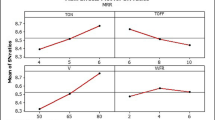Abstract
Wire electrical discharge machining (WEDM) is a commonly used process in manufacturing industries to machine electrically conductive materials with complex shapes and varying hardness. The performance of any machining process is based on right selection of input variables. The selection of optimal parameters in WEDM is a difficult task as it is a highly stochastic process in nature. The present work deals with the development of empirical relationships for the output responses of kerf (cutting width) and wire wear ratio considering pulse-on time, pulse-off time, wire tension, dielectric flow rate, and wire feed as the input variables. Response surface methodology is used to find the quantitative relations. Subsequently, the developed mathematical models are used for optimization. A recently developed global optimization technique, harmony search algorithm, is applied to find the optimal set of input control variables.
Similar content being viewed by others
References
Han F, Jiang J, Yu D (2007) Influence of machining parameters on surface roughness in finish cut of WEDM. Int J Adv Manuf Technol 34(5–6):538–546
Rajurkar KP, Wang WM (1993) Thermal modeling and on-line monitoring of wire-EDM. J Mater Process Technol 38(1–2):417–430
Huang JT, Liao YS, Hsue WJ (1999) Determination of finish cutting operation number and machining parameters setting in wire electrical discharge machining. J Mater Process Technol 87:69–81
Rozenek M, Kozak J, Dabro Vwki L, Lubko Vwki K (2001) Electrical discharge machining characteristics of metal matrix composites. J Matrix Process Technol 109:367–370
Lok YK, Lee TC (1997) Processing of advanced ceramics using the wire-cut EDM process. J Mater Process Technol 63(1–3):839–843
Scott D, Boyina S, Rajurkar KP (1991) Analysis and optimization of parameter combinations in wire electrical discharge machining. Int J Prod Res 29:2189–2207
Prasad DVSSSV, Gopalakrishna A (2009) Empirical modeling and optimization of wire electrical discharge machining. Int J Adv Manuf Technol 43:914–925
Ramakrishnan R, Karunamoorthy L (2006) Multi response optimization of wire EDM operations using robust design of experiments. Int J Adv Manuf Technol 29:105–112
Tosun N (2003) The effect of the cutting parameters on performance of WEDM. KSME. Int J 17(6):816–824
Tosun N, Cogun C, Tosun G (2004) A study on kerf and material removal rate in wire electrical discharge machining based on Taguchi method. J Mater Process Technol 152:316–322
Rong Tai Yang, Chorng Jyh Tzeng, Yung Kuang Yang, Ming Hua Hsieh (2011) Optimization of wire electrical discharge machining process parameters for cutting Tungsten. Int. J. Adv. Manuf. Technol. DOI 10.1007/s00170-011-3576-z
Gauri SK, Chakraborty S (2010) A study on the performance of some multi-response optimisation methods for WEDM processes. Int J Adv Manuf Technol 49:155–166
Patil NG, Brahmankar PK (2010) Some studies into wire electro-discharge machining of alumina particulate-reinforced aluminum matrix composites. Int J Adv Manuf Technol 48:537–555
Box GEP, Wilson KB (1951) Experimental attainment of optimum conditions. J R Stat Soc 13:1–45
Montgomery DC (2001) Design and analysis of experiments, 5th edn. Wiley, New York
Geem ZW, Kim JH, Loganathan GV (2001) A new heuristic optimization algorithm: harmony search. Simulation 76(2):60–68
Lee KS, Geem ZW (2004) A new meta-heuristic algorithm for continuous engineering optimization: harmony search theory and practice. J Comput Methods Appl Mech Engrg 194:3902–3933
Lee KS, Geem ZW (2004) A new structural optimization method based on the harmony search algorithm. J Comput Struct 82(9–10):781–798
Mahdavi M, Fesanghary M, Damangir E (2007) An improved harmony search algorithm for solving optimization problems. J Appl Math Comput 188:1567–1579
Vasebi A, Fesanghary M, Bathaee SMT (2007) Combined heat and power economic dispatch by harmony search algorithm. Int J Electrical Power Energy Syst 29:713–719
Fesanghary M, Mahdavi M, Minary M, Alizadeh Y (2008) Hybridizing harmony search algorithm with sequential quadratic programming for engineering optimization problems. J Comput Methods Appl Mech Eng 197:3080–3091
Design Expert, 7.1v. (2006) Stat-Ease Inc., 2021, E. Hennepin Avenue, Suite 480, Minneapolis.
Author information
Authors and Affiliations
Corresponding author
Rights and permissions
About this article
Cite this article
Prasad, D.V.S.S.S.V., Krishna, A.G. Empirical modeling and optimization of kerf and wire wear ratio in wire electrical discharge machining. Int J Adv Manuf Technol 77, 427–441 (2015). https://doi.org/10.1007/s00170-014-6445-8
Received:
Accepted:
Published:
Issue Date:
DOI: https://doi.org/10.1007/s00170-014-6445-8




